最新考研英语:同位语从句的识别
考研英语同位语从句知识点
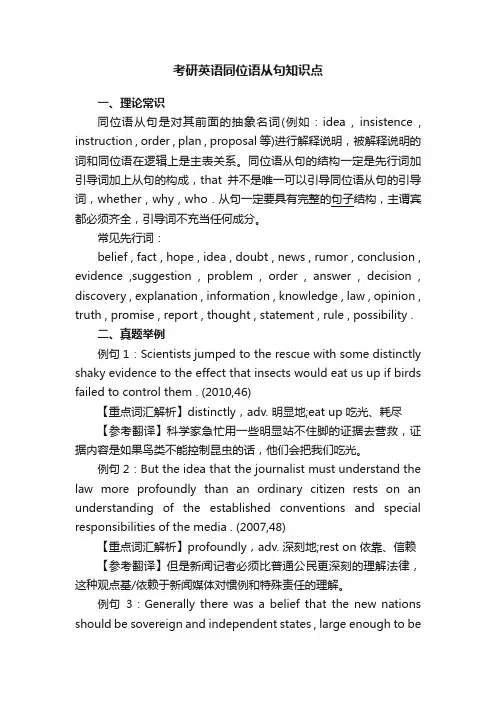
考研英语同位语从句知识点一、理论常识同位语从句是对其前面的抽象名词(例如:idea , insistence , instruction , order , plan , proposal等)进行解释说明,被解释说明的词和同位语在逻辑上是主表关系。
同位语从句的结构一定是先行词加引导词加上从句的构成,that并不是唯一可以引导同位语从句的引导词,whether , why , who . 从句一定要具有完整的句子结构,主谓宾都必须齐全,引导词不充当任何成分。
常见先行词:belief , fact , hope , idea , doubt , news , rumor , conclusion , evidence ,suggestion , problem , order , answer , decision , discovery , explanation , information , knowledge , law , opinion , truth , promise , report , thought , statement , rule , possibility .二、真题举例例句1:Scientists jumped to the rescue with some distinctly shaky evidence to the effect that insects would eat us up if birds failed to control them . (2010,46)【重点词汇解析】distinctly,adv. 明显地;eat up 吃光、耗尽【参考翻译】科学家急忙用一些明显站不住脚的证据去营救,证据内容是如果鸟类不能控制昆虫的话,他们会把我们吃光。
例句2:But the idea that the journalist must understand the law more profoundly than an ordinary citizen rests on an understanding of the established conventions and special responsibilities of the media . (2007,48)【重点词汇解析】profoundly,adv. 深刻地;rest on 依靠、信赖【参考翻译】但是新闻记者必须比普通公民更深刻的理解法律,这种观点基/依赖于新闻媒体对惯例和特殊责任的理解。
考研英语语法同位语从句和定语从句的区别
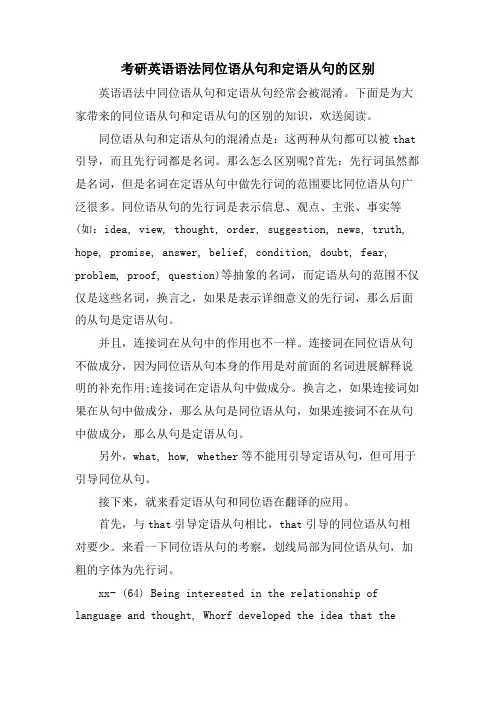
考研英语语法同位语从句和定语从句的区别英语语法中同位语从句和定语从句经常会被混淆。
下面是为大家带来的同位语从句和定语从句的区别的知识,欢送阅读。
同位语从句和定语从句的混淆点是:这两种从句都可以被that 引导,而且先行词都是名词。
那么怎么区别呢?首先:先行词虽然都是名词,但是名词在定语从句中做先行词的范围要比同位语从句广泛很多。
同位语从句的先行词是表示信息、观点、主张、事实等(如:idea, view, thought, order, suggestion, news, truth, hope, promise, answer, belief, condition, doubt, fear, problem, proof, question)等抽象的名词,而定语从句的范围不仅仅是这些名词,换言之,如果是表示详细意义的先行词,那么后面的从句是定语从句。
并且,连接词在从句中的作用也不一样。
连接词在同位语从句不做成分,因为同位语从句本身的作用是对前面的名词进展解释说明的补充作用;连接词在定语从句中做成分。
换言之,如果连接词如果在从句中做成分,那么从句是同位语从句,如果连接词不在从句中做成分,那么从句是定语从句。
另外,what, how, whether等不能用引导定语从句,但可用于引导同位从句。
接下来,就来看定语从句和同位语在翻译的应用。
首先,与that引导定语从句相比,that引导的同位语从句相对要少。
来看一下同位语从句的考察,划线局部为同位语从句,加粗的字体为先行词。
xx- (64) Being interested in the relationship of language and thought, Whorf developed the idea that thestructure of language determines the structure of habitual thought in a society.xx- (48) But the idea that the journalist must understand the law more profoundly than an ordinary citizen rests on an understanding of the established conventions and special responsibilities of the news media.xx- (48) On the other hand, he did not aept as well founded the charge made by some of his critics that, while he was a good observer, he had no power of reasoning.xx-(46) Scientists jumped to the rescue with some distinctly shaky evidence to the effect that insects would eat us up if birds failed to control them.xx- (48) Time was when biologists somewhat overworked the evidence that these creatures preserve the health of game by killing the physically weak, or that they prey only on “worthless” species.xx-(46) Allen’s contribution was to take an assumption we all share—that because we are not robots we therefore control our thoughts—and reveal its erroneous nature.(46) But even as the number of English speakers expands further there are signs that the global predominance of the language may fade within the foreseeable future.1997-(74) Arguing from the view that humans are different from animals in every relevant respect,extremists of this kind think that animals lie outside the area of moral choice.再次,我们来看一下that引导的定语从句,举两个例子:xx-(71) There will be television chat shows hosted by robots, and cars with pollution monitors that will disable them when they offend.Pearson has pieced together the work of hundreds of researchers around the world to produce a unique millennium technology calendar that gives the latest dates when we can expect hundreds of key breakthroughs and discoveries to take place.对于同位语从句,同位语的先行词不是定语成分,而是被定语所修饰的名词,翻译方法可以是“先行词+是+同位语从句”。
英语同位语从句用法详解
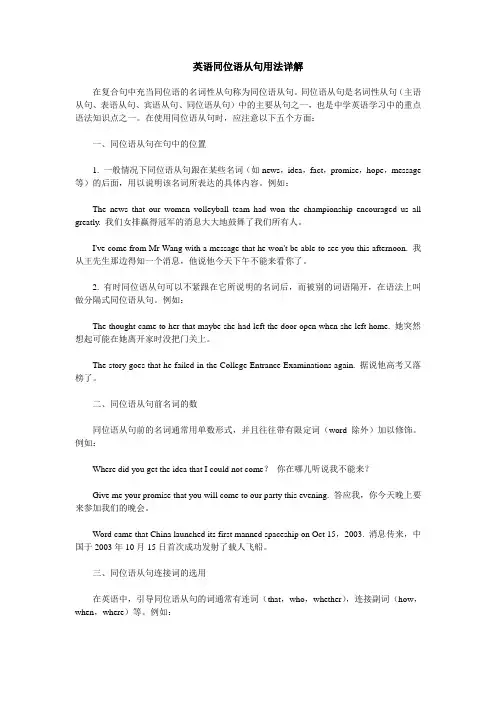
英语同位语从句用法详解在复合句中充当同位语的名词性从句称为同位语从句。
同位语从句是名词性从句(主语从句、表语从句、宾语从句、同位语从句)中的主要从句之一,也是中学英语学习中的重点语法知识点之一。
在使用同位语从句时,应注意以下五个方面:一、同位语从句在句中的位置1. 一般情况下同位语从句跟在某些名词(如news,idea,fact,promise,hope,message 等)的后面,用以说明该名词所表达的具体内容。
例如:The news that our women volleyball team had won the championship encouraged us all greatly. 我们女排赢得冠军的消息大大地鼓舞了我们所有人。
I've come from Mr Wang with a message that he won't be able to see you this afternoon. 我从王先生那边得知一个消息,他说他今天下午不能来看你了。
2. 有时同位语从句可以不紧跟在它所说明的名词后,而被别的词语隔开,在语法上叫做分隔式同位语从句。
例如:The thought came to her that maybe she had left the door open when she left home. 她突然想起可能在她离开家时没把门关上。
The story goes that he failed in the College Entrance Examinations again. 据说他高考又落榜了。
二、同位语从句前名词的数同位语从句前的名词通常用单数形式,并且往往带有限定词(word除外)加以修饰。
例如:Where did you get the idea that I could not come?你在哪儿听说我不能来?Give me your promise that you will come to our party this evening. 答应我,你今天晚上要来参加我们的晚会。
考研英语同位语
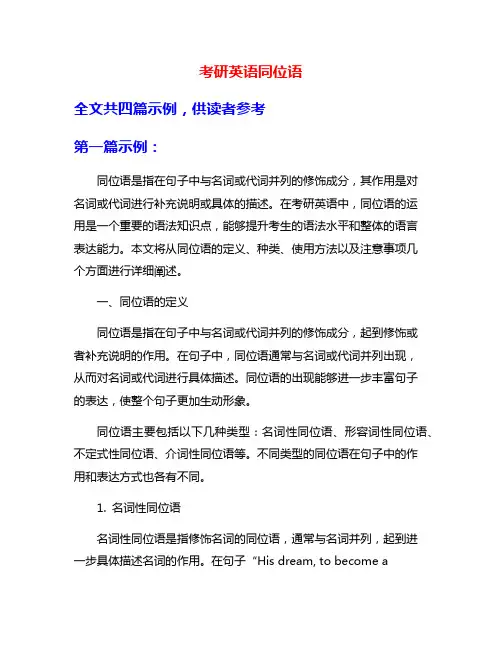
考研英语同位语全文共四篇示例,供读者参考第一篇示例:同位语是指在句子中与名词或代词并列的修饰成分,其作用是对名词或代词进行补充说明或具体的描述。
在考研英语中,同位语的运用是一个重要的语法知识点,能够提升考生的语法水平和整体的语言表达能力。
本文将从同位语的定义、种类、使用方法以及注意事项几个方面进行详细阐述。
一、同位语的定义同位语是指在句子中与名词或代词并列的修饰成分,起到修饰或者补充说明的作用。
在句子中,同位语通常与名词或代词并列出现,从而对名词或代词进行具体描述。
同位语的出现能够进一步丰富句子的表达,使整个句子更加生动形象。
同位语主要包括以下几种类型:名词性同位语、形容词性同位语、不定式性同位语、介词性同位语等。
不同类型的同位语在句子中的作用和表达方式也各有不同。
1. 名词性同位语名词性同位语是指修饰名词的同位语,通常与名词并列,起到进一步具体描述名词的作用。
在句子“His dream, to become ascientist, has finally come true.”中,to become a scientist就是名词性同位语,对名词dream进行具体描述。
三、同位语的使用方法同位语的使用方法主要有以下几点需要注意:1. 同位语通常出现在名词或代词后面,并且与名词或代词并列排列,在整个句子中起到修饰或者补充说明的作用。
2. 同位语应该与其修饰的名词或代词在语法上保持一致,即在性、数、格方面要保持一致。
3. 同位语的位置通常在句子中比较靠近名词或代词,以便更好地修饰名词或代词,使整个句子更加清晰明了。
4. 在使用同位语时,需要注意同位语与其修饰的名词或代词之间的逻辑关系,使句子的表达更加准确和得体。
四、同位语的注意事项1. 对同位语的种类和用法进行深入理解,掌握不同类型同位语的特点和表达方式,能够更好地运用同位语进行句子表达。
3. 在写作中,合理运用同位语丰富句子表达,使句子更加生动、具体、传神,从而提升整体写作水平。
英语同位语从句的判定技巧
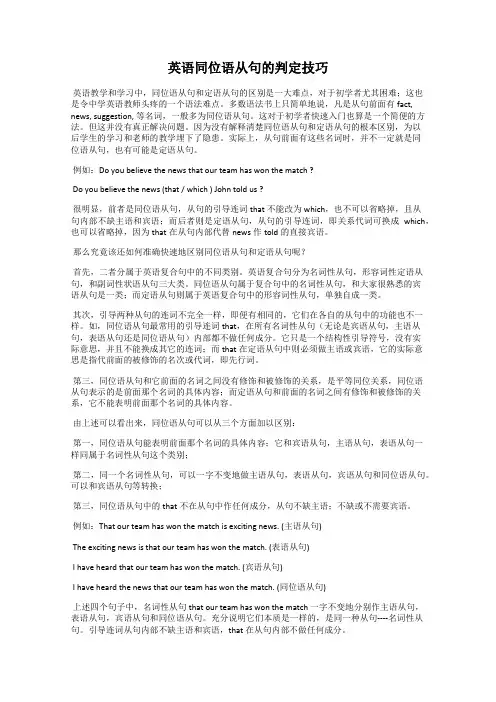
英语同位语从句的判定技巧英语教学和学习中,同位语从句和定语从句的区别是一大难点,对于初学者尤其困难;这也是令中学英语教师头疼的一个语法难点。
多数语法书上只简单地说,凡是从句前面有fact, news, suggestion, 等名词,一般多为同位语从句。
这对于初学者快速入门也算是一个简便的方法。
但这并没有真正解决问题。
因为没有解释清楚同位语从句和定语从句的根本区别,为以后学生的学习和老师的教学埋下了隐患。
实际上,从句前面有这些名词时,并不一定就是同位语从句,也有可能是定语从句。
例如:Do you believe the news that our team has won the match ?Do you believe the news (that / which ) John told us ?很明显,前者是同位语从句,从句的引导连词that 不能改为which,也不可以省略掉,且从句内部不缺主语和宾语;而后者则是定语从句,从句的引导连词,即关系代词可换成which,也可以省略掉,因为that在从句内部代替news作told的直接宾语。
那么究竟该还如何准确快速地区别同位语从句和定语从句呢?首先,二者分属于英语复合句中的不同类别。
英语复合句分为名词性从句,形容词性定语从句,和副词性状语从句三大类。
同位语从句属于复合句中的名词性从句,和大家很熟悉的宾语从句是一类;而定语从句则属于英语复合句中的形容词性从句,单独自成一类。
其次,引导两种从句的连词不完全一样,即便有相同的,它们在各自的从句中的功能也不一样。
如,同位语从句最常用的引导连词that,在所有名词性从句(无论是宾语从句,主语从句,表语从句还是同位语从句)内部都不做任何成分。
它只是一个结构性引导符号,没有实际意思,并且不能换成其它的连词;而that在定语从句中则必须做主语或宾语,它的实际意思是指代前面的被修饰的名次或代词,即先行词。
第三,同位语从句和它前面的名词之间没有修饰和被修饰的关系,是平等同位关系,同位语从句表示的是前面那个名词的具体内容;而定语从句和前面的名词之间有修饰和被修饰的关系,它不能表明前面那个名词的具体内容。
同位语从句的判定方法
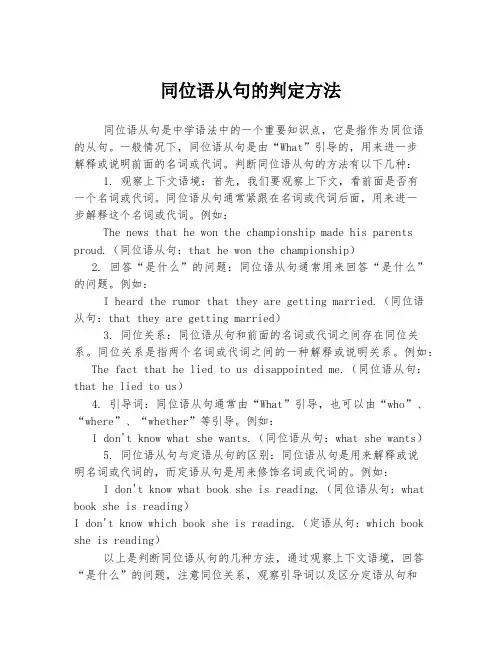
同位语从句的判定方法同位语从句是中学语法中的一个重要知识点,它是指作为同位语的从句。
一般情况下,同位语从句是由“What”引导的,用来进一步解释或说明前面的名词或代词。
判断同位语从句的方法有以下几种:1. 观察上下文语境:首先,我们要观察上下文,看前面是否有一个名词或代词。
同位语从句通常紧跟在名词或代词后面,用来进一步解释这个名词或代词。
例如:The news that he won the championship made his parents proud.(同位语从句:that he won the championship)2. 回答“是什么”的问题:同位语从句通常用来回答“是什么”的问题。
例如:I heard the rumor that they are getting married.(同位语从句:that they are getting married)3. 同位关系:同位语从句和前面的名词或代词之间存在同位关系。
同位关系是指两个名词或代词之间的一种解释或说明关系。
例如:The fact that he lied to us disappointed me.(同位语从句:that he lied to us)4. 引导词:同位语从句通常由“What”引导,也可以由“who”、“where”、“whether”等引导。
例如:I don't know what she wants.(同位语从句:what she wants)5. 同位语从句与定语从句的区别:同位语从句是用来解释或说明名词或代词的,而定语从句是用来修饰名词或代词的。
例如:I don't know what book she is reading.(同位语从句:what book she is reading)I don't know which book she is reading.(定语从句:which book she is reading)以上是判断同位语从句的几种方法,通过观察上下文语境,回答“是什么”的问题,注意同位关系,观察引导词以及区分定语从句和同位语从句,我们就能准确判断出同位语从句的存在。
英语同位语从句相关知识讲解
英语同位语从句相关知识讲解英语语法中的从句有:名词性从句(主语从句、表语从句、宾语从句同位语从句)、形容词性从句(定语从句)、副词性从句(状语从句)。
英语从句的重点是,熟悉连接从句的连词、关系词的各种含义以及用法。
一、名词性从句英语语法中的名词性从句,在句子中起名词或者名词词组作用。
在英语复合句中充当主语、宾语、表语、同位语、介词宾语等。
因此,自然就有主语从句、宾语从句、表语从句和同位语从句。
1.同位语从句说明前一个名词具体内容的从句,一般位于被说明的名语之后,在含义上它与被说明的名词相等。
•引导同位语从句的连词,最常见的是that,其次还有whether,what, which, who, when, where, why, how 等词。
1.由that引导The fact that everyone loves money is common sense.人人爱钱是常识。
注意:此句的the fact=that everyone loves money说明同位语从句的名词,只是表达“语言、想法、事实”等少数抽象名词,大多数句词不能也不需要接同位语从句,常见的有:idea想法thought想法question问题fact事实belief信念answer回答reply回复rumor谣言news消息order命令hope希望promise诺言suggestion建议doubt怀疑saying格言I like the idea that we hold an evening party.我喜欢开晚会这个想法。
Do you remember your promise that you treat us to hamburgers?你还记得你请我们吃汉堡包的承诺吗?The hope that every family owns a car will come true.每家有小车的希望会实现的。
注意:引导同位语从句的连词that通常不省略,但在非正式文体中也可以省去。
同位语从句讲解
④ 引导同位语从句的连词不可省略;引导 定语从句的关系代词作宾语时常可省 略。 The news that he has been elected monitor of our class is true. The news (that) he told me is exciting.
⑤ 同位语从句与先行词一般可变成一个完 整句子, 谓语动词用be的不同形式。 He heard the news that their team had won. 此句可以变为一个表语从句: The news was that their team had won.
(6) 由 of 引导 The city of Beijing has been greatly changed since 2000. 自从2000年以来, 北京市发生了很 大的变化。
(7) 由 or 引导 The freezing temperature, or freezing point, is the temperature at which water freezes under ordinary pressure. 结冰温度即冰点,是水在常压下结冰 时的温度。
4. Time travel is possible./We have no scientific proof for the idea.
We have no scientific proof for the idea that time travel is possible.
5. Students should be given more free time./The suggestion is welcomed by many people.
2. The Queen of England was on a four-day visit in China./We heard the news last night.
考研英语语法同位语从句和定语从句的区别
考研英语语法同位语从句和定语从句的区别英语语法中同位语从句和定语从句经常会被混淆。
下面是小编为大家带来的同位语从句和定语从句的区别的知识,欢迎阅读。
同位语从句和定语从句的区别同位语从句和定语从句的混淆点是:这两种从句都可以被that引导,而且先行词都是名词。
那么怎么区别呢?首先:先行词虽然都是名词,但是名词在定语从句中做先行词的范围要比同位语从句广泛很多。
同位语从句的先行词是表示信息、观点、主张、事实等(如:idea, view, thought, order, suggestion, news, truth, hope, promise, answer, belief, condition, doubt, fear, problem, proof, question)等抽象的名词,而定语从句的范围不仅仅是这些名词,换言之,如果是表示具体意义的先行词,那么后面的'从句是定语从句。
并且,连接词在从句中的作用也不一样。
连接词在同位语从句不做成分,因为同位语从句本身的作用是对前面的名词进行解释说明的补充作用;连接词在定语从句中做成分。
换言之,如果连接词如果在从句中做成分,则从句是同位语从句,如果连接词不在从句中做成分,则从句是定语从句。
另外,what, how, whether等不能用引导定语从句,但可用于引导同位从句。
接下来,就来看定语从句和同位语在考研英语翻译的应用。
首先,与that引导定语从句相比,that引导的同位语从句相对要少。
来看一下同位语从句的考察,划线部分为同位语从句,加粗的字体为先行词。
2004- (64) Being interested in the relationship of language and thought, Whorf developed the idea that the structure of language determines the structure of habitual thought in a society.2007- (48) But the idea that the journalist must understand the law more profoundly than an ordinary citizen rests on an understanding of the established conventions and special responsibilities of the news media.2008- (48) On the other hand, he did not accept as well founded the charge made by some of his critics that, while he was a good observer, he had no power of reasoning.2010-(46) Scientists jumped to the rescue with some distinctly shaky evidence to the effect that insects would eat us up if birds failed to control them.2010-(48) Time was when biologists somewhat overworked the evidence that these creatures preserve the health of game by killing the physically weak, or that they prey only on “worthless” species.2011-(46) Allen’s contribution was to take an assumption we all share—that because we are not robots we therefore control our thoughts—and reveal its erroneous nature.(46) But even as the number of English speakers expands further there are signs that the global predominance of the language may fade within the foreseeable future.1997-(74) Arguing from the view that humans are different from animals in every relevant respect, extremists of this kind think that animals lie outside the area of moral choice.再次,我们来看一下that引导的定语从句,举两个例子:2001-(71) There will be television chat shows hosted by robots, and cars with pollution monitors that will disable them when they offend.Pearson has pieced together the work of hundreds of researchers around the world to produce a unique millennium technology calendar that gives the latest dates when we can expect hundreds of key breakthroughs and discoveries to take place.对于同位语从句,同位语的先行词不是定语成分,而是被定语所修饰的名词,翻译方法可以是“先行词+是+同位语从句”。
2020考研英语:同位语从句和定语从句的区别
2020考研英语:同位语从句和定语从句的区别考研英语有许多题目组成,方便大家及时了解,下面由小编为你精心准备了“2020考研英语:同位语从句和定语从句的区别”,持续关注本站将可以持续获取更多的考试资讯!2020考研英语:同位语从句和定语从句的区别首先,同位语从句中连接词that在句子中不作句子成分,没有具体含义,只起连接作用,它的作用可以解释为一个冒号;而定语从句中的that是关系代词,它在句子中是充当成分的。
同位语从句和定语从句的区别具体如下:1. 被修饰的词不同:同位语从句的前面一般是表示抽象意义的名词(通常有:news, idea, fact, promise, question, doubt, thought, hope, massage, suggestion, possibility, order, truth, proposal, belief);而定语从句的先行词一般指人或指物。
例如:However, the conventional view that education should be one of the very highest priorities for promoting rapid economic development in poor countries is wrong. (2009年Text 3)【同位语从句】Homeless individuals manage to find a shelter that will give them three meals a day and a place to sleep at night.(2006年完形)【定语从句】2. 从句的作用不同:同位语从句表示的是先行词的具体内容;定语从句是对先行词的限制、描绘或说明。
Instead, the studies ended up giving their name to the “Hawthorne effect”, the extremely influential idea that the very act of being experimented upon changed subjects’ behavior. (2010年完形)【同位语从句】Teachers need to be aware of the emotional, intellectual, and physical changes that young adults experience. (2003年完形)【定语从句】3. 引导词的作用不同:引导同位语的that是连词,在从句中不作成分;而引导定语从句的that为关系代词,从从句中作成分。
- 1、下载文档前请自行甄别文档内容的完整性,平台不提供额外的编辑、内容补充、找答案等附加服务。
- 2、"仅部分预览"的文档,不可在线预览部分如存在完整性等问题,可反馈申请退款(可完整预览的文档不适用该条件!)。
- 3、如文档侵犯您的权益,请联系客服反馈,我们会尽快为您处理(人工客服工作时间:9:00-18:30)。
众所周知,英语有三大从句,分别是主语从句,定语从句和状语从句。
而名词性从句包括主语从句、宾语从句、表语从句和同位语从句。
在主从复合句中,从句可以充当主句的主语、表语、宾语或同位语。
由于在多数情况下,主语、表语、宾语或同位语这四种句子成分由名词性词类充当,所以,我们把这些作用相当于名词的从句统称为名词性从句,把充当主语、表语、宾语或同位语的从句分别称为主语从句、表语从句、宾语从句或同位语从句。
也就是说充当什么成分就叫什么从句。
在考研英语中,同位语从句在句中有两种位置:要么紧挨着所解释的名词,要么跟所解释的名词之间有其它成分。
下面跨考教育英语教研室谷存波老师分别举例进行说明。
比如:Arguing from the view that humans are different from animals in every relevant respect,extremists of this kind think that animals lie outside the area of moral choice.这类人持极端看法,认为人与动物在各相关方面都不相同,对待动物无须考虑道德问题。
此句中,view后面有个that引导的同位语从句。
从句用来解释view的具体内容。
再如:The debate whether there should be more free sports facilities for the public continued. 关于是否应该有更多的免费的体育设施对公众开放的争论从未停止过。
此句中,debate后面紧接着一个whether引导的同位语从句,解释debate的具体内容。
同位语从句有时跟所解释的名词之间有其它成分。
比如:Concerns were raised that witnesses might be encouraged to exaggerate their stories in court to ensure guilty verdicts. 有人表示担心,证人可能会受到鼓励,为了确保有罪的裁定而在法庭上夸大其辞。
跨考教育谷存波老师认为:学习同位语从句的难点是能够区分开同位语从句和定语从句。
先从最常见的定语从句说起:定语是用来修饰、限定名词或代词的品质与特征的。
如果是一个句子担任定语,那么这个句子就是定语从句。
一个名词(或其它形式)对另一个名词或代词进行修饰,限定或说明,这个名词(或其它形式)就是同位语。
在复合句中充当同位语的名词性从句称为同位语从句。
两种从句很相似,但还是有区别的,区别主要在以下三方面:
1. 从词类上区别:
同位语从句前面只能是idea,fact,hope,news等抽象名词,而定语从句的先行词可以是名词(多是具体名词)、代词,主句的一部分或是整个主句,如:
The possibility that the majority of the labour force will work at home is often discussed.(同位语从句)
Our team has won the game, which made us very happy. (定语从句)
2. 从性质上区别:
定语从句是从句对其先行词的修饰或限制,属于形容词性从句的范畴;而同位语从句是从句对前面抽象名词的进一步的说明和解释,属于名词性从句的范畴,如:
The news that our team has won the game was true.
(同位语从句,补充说明news到底是一个什么消息。
)
The news that he told me yesterday was true.
(定语从句,news在从句中作told的宾语。
)
3. 从引导词及其在句子中的成分上区别:
有些引导词如how, whether, what可以引导同位语从句,但不能引导定语从句,如:
That question whether we need it has not been considered.
我们是否需要它这个问题还没有考虑。
(同位语从句)
引导词that引导定语从句时,在从句中一般作主语或宾语(指物时还可以用which代替),并且作宾语时常常省略
,that在同位语从句中仅起连接作用,不充当任何成分,并且不能省略,也不能用which来代替,如:
The order that we should send a few people to help the other groups was received yesterday.
我们应派几个人去帮别的几个小组的命令昨天收到了。
(同位语从句。
是对order的具体解释,that虽不作成分,但不能省略。
)
The order that we received yesterday was that we should send a few people to help the other groups. 我们昨天收到的命令是我们应该派几个人去帮助别的几个小组。
(定语从句,是名词order的修饰语,that在从句中作received的宾语,可以省略。
)
最后来看真题中的一句,来自2004年阅读第四篇:
These leaders are living proof that prevention works and that we can manager the health problems
that come naturally with age.
大家来分析下,看看三个that分别引导的是什么从句。
分析出来了吗?前面两个that引导的是同位语从句,最后一
个that引导的是定语从句,that在定语从句中做主语。
